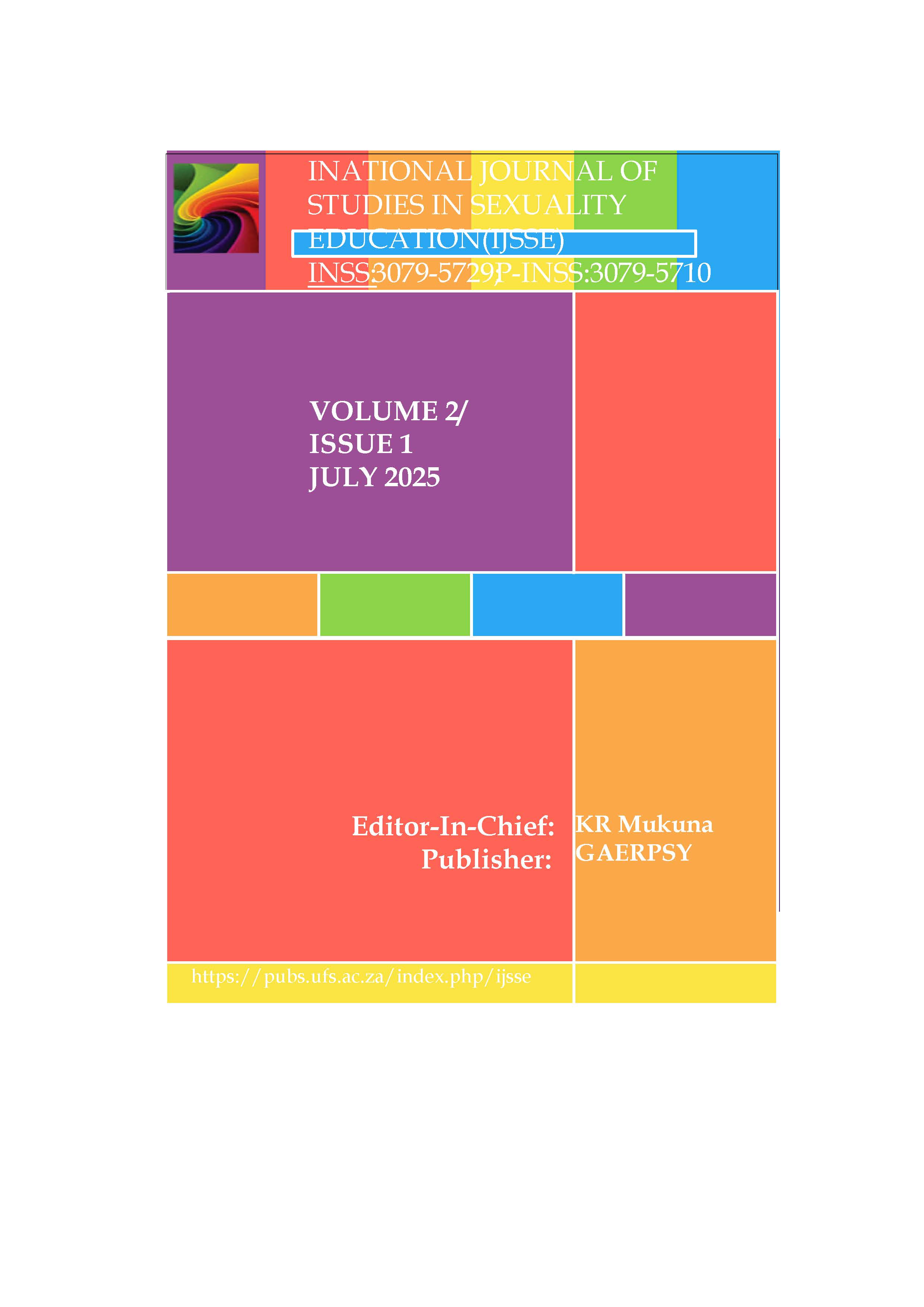Intersecting the right to health of male secondary learners in a rural Chiredzi North, Zimbabwe: Challenges and strategies
DOI:
https://doi.org/10.38140/ijsse.v1i2.2124Keywords:
Male secondary learners, Mental health , Sexual abuse , StigmatisationAbstract
The study unpacks the limited literature. It deals with the barriers male learners face in rural Chiredzi North, Zimbabwe, in accessing their right to health, highlighting systemic challenges and potential strategies for improvement. This study explores the challenges of male secondary school learners regarding sexual abuse. It determines strategies to enhance their mental health support, which can protect them from sexual abuse in rural Chiredzi North in Zimbabwe. Fifteen participants were purposively selected based on gender, expertise, and geographical location, ensuring diverse representation of perspectives. They comprised four male learners, two teachers, one counsellor, one police officer, two village heads, two officials from the Ministry of Primary and Secondary Education, two parents, one Ministry of Health Official, one Ministry of Justice and Legal Affairs official. Data were collected through two focus group discussions: one specifically for young learners and another for adult participants. Data were subsequently analysed using thematic analysis, which facilitated identifying key themes. The findings revealed that male learners often experienced profound feelings of isolation and stigmatisation, which intensified their psychological distress and deterred them from seeking help. The findings indicated that enhancing community health education and increasing access to healthcare services are vital strategies to address male secondary learners' intersecting right to health in rural Chiredzi North, Zimbabwe. Considering these findings, recommended that educational institutions and community organisations develop and implement awareness programmes focused on the rights against sexual abuse and the right to mental health.
Keywords: Male secondary learners, Mental health, Sexual abuse, Stigmatisation
References
Blunden, H., Giuntoli, G., Newton, B. J., & Katz, I. (2021). Victims/survivors’ perceptions of helpful institutional responses to incidents of institutional child sexual abuse. Journal of Child Sexual Abuse, 30(1), 56–79. https://doi.org/10.1080/10538712.2020.1801932
Braun, V., & Clarke, V. (2006). Using thematic analysis in psychology. Qualitative Research in Psychology, 3(2), 77-101.
Butt, S., Chou, S., & Browne, K. (2011). A rapid systematic review on the association between childhood physical and sexual abuse and illicit drug use among males. Child Abuse Review, 20(1), 6–38. https://doi.org/10.1002/car.1100
Carr, A., Nearchou, F., Duff, H., Mhaoileoin, D. N., Cullen, K., O’Dowd, A., & Battigelli, L. (2019). Survivors of institutional abuse in long-term child care in Scotland. Child Abuse & Neglect, 9(3), 38–54. https://doi.org/10.1016/j.chiabu.2019.04.018
Charamba, J., & Makonye, F. (2024). Impact of parental involvement (PI) in the education of children with intellectual impairment in Bulawayo Metropolitan Province, Zimbabwe. African Journal of Sociological and Psychological Studies, 4(1), 119–131. https://doi.org/10.31920/2752-6585/2024/v4n1a6
Coburn, P. I., Harvey, M. B., Anderson, S. F., Price, H. L., Chong, K., & Connolly, D. A. (2019). Boys abused in a community setting: An analysis of gender, relationship, and delayed prosecutions in cases of child sexual abuse. Journal of Child Sexual Abuse, 28(5), 586–607. https://doi.org/10.1080/10538712.2019.1580329
Creswell, J. W., & Poth, C. N. (2018). Qualitative inquiry and research design: Choosing among five approaches. London: Sage publications
Easton, S. D. (2019). Childhood disclosure of sexual abuse and mental health outcomes in adulthood: Assessing merits of early disclosure and discussion. Child Abuse & Neglect, 9(3), 208–214. https://doi.org/10.1016/j.chiabu.2019.04.005
Faden, R. R., Beauchamp, T. L., King, N. M. P., & Pritchard, D. E. (2024). A history and theory of informed consent. Oxford: Oxford University Press.
Finkelhor, D., Pacella, R., Meinck, F., & Malacova, E. (2023). Methodology of the Australian Child Maltreatment Study (ACMS): A national survey of the prevalence of child maltreatment and its correlates. Medical Journal of Australia, 218(Suppl 6), S5–S12. https://doi.org/10.5694/mja2.51869
Fry, D., Fang, X., Elliott, S., Casey, T., Zheng, X., Li, J., ... & McCluskey, G. (2018). The relationships between violence in childhood and educational outcomes: A global systematic review and meta-analysis. Child Abuse & Neglect, 75, 6–28. https://doi.org/10.1016/j.chiabu.2017.06.021
Government of Zimbabwe. (2013). Constitution of Zimbabwe Amendment (No. 20). Harare: Government Printers.
Haslam, D. M., Lawrence, D. M., Mathews, B., Higgins, D. J., Hunt, A., Scott, J. G., ... & Malacova, E. (2023). The Australian Child Maltreatment Study (ACMS), a national survey of the prevalence of child maltreatment and its correlates: methodology. Medical Journal of Australia, 218, S5-S12. https://doi.org/10.5694/mja2.51869
Hunt, G. R., Higgins, D. J., Willis, M. L., Mathews, B., Lawrence, D., Meinck, F., ... & Haslam, D. M. (2024). The prevalence of child sexual abuse perpetrated by leaders or other adults in religious organizations in Australia. Child Abuse & Neglect, 14(7), 106946. https://doi.org/10.1016/j.chiabu.2024.106946
Krinkin, Y., Enosh, G., & Dekel, R. (2022). The religious implications of being sexually abused by a rabbi: Qualitative research among Israeli religious men. Child Abuse & Neglect, 13(4), 105901. https://doi.org/10.1016/j.chiabu.2022.105901
Liamputtong, P. (2018). Researching the vulnerable: A guide to sensitive research methods. London: Sage.
Lusky-Weisrose, E. (2021). Maybe what happened is actually OK? Child sexual abuse by authority figures in the ultra-orthodox community in Israel: Survivors’ perceptions of their relationships with the perpetrator. Child Abuse & Neglect, 122, 105325. https://doi.org/10.1016/j.chiabu.2021.105325
Margherita, M., Franceschetti, L., Maggioni, L., Vignali, G., Kustermann, A., & Cattaneo, C. (2021). Male victims of sexual abuse and domestic violence: A steadily increasing phenomenon. Medicine, Science & the Law, 61(1_suppl), 54–61. https://doi.org/10.1177/0025802420947003
Mathews, B., Finkelhor, D., Pacella, R., Scott, J. G., Higgins, D. J., Meinck, ….., & Malacova, E. (2024). Child sexual abuse by different classes and types of perpetrator: Prevalence and trends from an Australian national survey. Child Abuse & Neglect, 147, 106562. https://doi.org/10.1016/j.chiabu.2023.106562
McKeever, N. (2019). Can a woman rape a man and why does it matter? Criminal Law and Philosophy, 13(4), 599–619. https://doi.org/10.1007/s11572-018-9485-6.
O’Gorman, K., Pilkington, V., Seidler, Z., Oliffe, J. L., Peters, W., Bendall, S., & Rice, S. M. (2023). Childhood sexual abuse in boys and men: The case for gender-sensitive interventions. Psychological Trauma: Theory, Research, Practice, and Policy, 16(Suppl 1), S181–S189. https://doi.org/10.1037/tra0001520
Pankowiak, A., Woessner, M. N., Parent, S., Vertommen, T., Eime, R., Spaaij, R., ... & Parker, A. G. (2023). Psychological, physical, and sexual violence against children in Australian community sport: Frequency, perpetrator, and victim characteristics. Journal of Interpersonal Violence, 38(3-4), 4338–4365. https://doi.org/10.1177/08862605221114155
Pereda, N., Contreras Taibo, L., Segura, A., & Maffioletti Celedón, F. (2022). An exploratory study on mental health, social problems and spiritual damage in victims of child sexual abuse by Catholic Clergy and other perpetrators. Journal of Child Sexual Abuse, 31(4), 393-411. https://doi.org/10.1080/10538712.2022.2080142
Rapsey, C., Campbell, A., Clearwater, K., & Patterson, T. (2020). Listening to the therapeutic needs of male survivors of childhood sexual abuse. Journal of Interpersonal Violence, 35(9–10), 2033–2054. https://doi.org/10.1177/0886260517701453
Reed, R. A., Pamlanye, J. T., Truex, H. R., Murphy-Neilson, M. C., Kunaniec, K. P., Newins, A. R., & Wilson, L. C. (2019). Higher rates of unacknowledged rape among men: The role of rape myth acceptance. Psychology of Men & Masculinities, 21(1), 162–167. https://doi.org/10.1037/men0000230.
Ressel, M., Lyons, J., & Romano, E. (2018). Abuse characteristics, multiple victimisation and resilience among young adult males with histories of childhood sexual abuse. Child Abuse Review, 27(3), 239-253. https://doi.org/10.1002/car.2508
Saruchera, M., & Chidarikire, M. (2025). Educators’ role in mitigating suicidal propensities among Zimbabwe rural secondary male learners: An exploration of challenges and intervention mechanisms. Research in Social Sciences and Technology, 10(1), 355-374. https://doi.org/10.46303/ressat.2025.19
Saruchera, M., & Chidarikire, M. (2025). Obstacles to accessing pre-exposure prophylaxis for rural Zimbabwean female learners with profound hearing impairments: Proposed solutions. International Journal of Religion, 6(1), 314–325. https://doi.org/10.61707/c0ek3470
Scott, J. G., Malacova, E., Mathews, B., Haslam, D. M., Pacella, R., Higgins, D. J., ... & Thomas, H. J. (2023). The association between child maltreatment and mental disorders in the Australian Child Maltreatment Study. Medical Journal of Australia, 218(Suppl 6), S26–S33. https://doi.org/10.5694/mja2.51870
Temkin, J., Gray, J. M., & Barrett, J. (2018). Different functions of rape myth use in court: Findings from a trial observation study. Feminist Criminology, 13(2), 205–226. https://doi.org/10.1177/1557085116661627.
Thomas, J. C., & Kopel, J. (2023). Male victims of sexual assault: A review of the literature. Behavioral Sciences, 13(4), 304–323. https://doi.org/10.3390/bs13040304.
Walfield, S. M. (2021). Men cannot be raped”: Correlates of male rape myth acceptance. Journal of Interpersonal Violence, 36(13-14), 6391–6417. https://doi.org/10.1177/0886260518817777.
Walfield, S. M., McCormack, P. D., & Clarke, K. (2022). Understanding case outcomes for male victims of forcible sexual assaults. Journal of Interpersonal Violence, 37(9-10), 6929–6957. https://doi.org/10.1177/0886260520967154.
Weare, S. (2021). I feel permanently traumatized by it: Physical and emotional impacts reported by men forced to penetrate women in the United Kingdom. Journal of Interpersonal Violence, 36(13-14), 6621–6646. https://doi.org/10.1177/0886260518820815.
Williams, L. M., & Toney, S. (2023). Rape and sexual assault. In H. S. Friedman & C. H. Markey (Eds.), Encyclopedia of mental health (3rd ed., pp. 24–35). Elsevier. https://doi.org/10.1016/B978-0-323-91497-0.00165-X.
World Health Organisation (WHO). (2019). Health and Human Rights: A Global Perspective. London. WHO Publications.
Zalcberg, S. (2017). The place of culture and religion in patterns of disclosure and reporting sexual abuse of males: A case study of ultra orthodox male victims. Journal of Child Sexual Abuse, 26(5), 590–607. https://doi.org/10.1080/10538712.2017.1316335.
Additional Files
Published
How to Cite
Issue
Section
License
Copyright (c) 2025 Munyaradzi Chidarikire, Saruchera Munyaradzi

This work is licensed under a Creative Commons Attribution-NonCommercial-NoDerivatives 4.0 International License.






